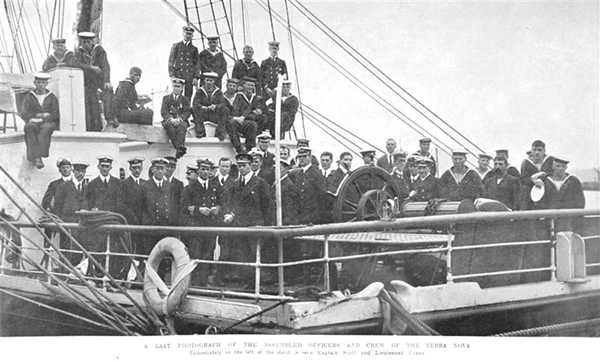Mainstream media missing from wild new frontiers


Last Frontier: Robert Falcon Scott and the crew of the Terra Nova mesmerised a society still excited to explore the world. Now, apparently bored with life on Earth, the world’s media is largely indifferent to the urgent exploration upon which civilsation’s fate now hangs. image Otago Daily Times
As threats go, they don’t come much bigger. Asteroid strike, global thermonuclear war, nuclear winter, snowball earth all have the potential to render Homo sapiens sapiens extinct.
But these threats have either a low, in some cases infinitesimally low, possibility of occurring—no asteroid on the National Aeronautics and Space Administration’s 100-year Sentry list rates higher than one, on the 10-point Torino hazard scale.
Anthropogenic global warming, on the other hand, is no mere threat. It is a reality, and a rapidly escalating one. But what is not widely ventilated is that the current trajectory of fossil fuel consumption, unchecked, guarantees an outcome more spectacular than any asteroid impact Earth since life here evolved.
There has long been a preoccupation with peak oil and even peak coal—it is self-evident that deposits are finite. But what has changed is the recent realisation that there is sufficient fossil fuel, if combusted, to cause runaway global warming culminating in an atmosphere so carbon dioxide –drenched that the oceans are evaporated and life itself is extinguished.
Asteroid 1999 RQ36, with an only one-in-one-thousand chance of hitting Earth, in a century and a half’s time, is short-listed as the destination of a US$650 million New Frontiers mission. Certainly the mission, if approved, would help improve the accuracy of asteroid trajectory prediction generally, and this may prove critical over the next millennia or more. Compared to global warming prediction, however, this need is not urgent.
The new frontiers that urgently need to be better explored and better understood are those of the rapidly warming home planet. Although answers to these questions are pouring in practically daily, vast areas are under-researched, including atmospheric aerosols and methane venting to the atmosphere. The reason Earth’s temperature has been slow to reflect the rise in carbon dioxide is the inertia of the oceans, about which far too little is known. James Hansen:
The situation in the deep ocean is worse. There is not enough good data.
Atmospheric aerosols are a frontier that Dr Hansen has been urging the National Aeronautics and Space Administration to study for years. In two months time the Glory low orbit satellite is finally scheduled to begin this crucial mission. It could have been working on the problem long since if it were not for the asinine, popular, science-fiction-fueled preoccupation with manned flight.
So far, global warming is playing to a near-empty theatre. This is partly due to the success of industry-paid merchants of doubt, in selling global warming as alarmist and unproven. Instead of floods and wildfire being reported as the forecast face of global warming, the media is loath to make the link lest it be deluged by disinformers and denialists. Or worse: Chastised by climate scientists for failure to adhere to adequately nuanced phrases, such as:
…consistent with the expectations with regards to global warming…
Higher average temperatures and percentage of water vapour are bringing more extreme, and more-extreme, weather events. But the media is fearful of making the link—effectively saying ‘Keep moving; nothing to see here folks; keep moving!’ But even Russia’s president has been prised from his denialist position, by a heat wave so severe that an extra 2000 have drowned seeking respite:
What’s happening with the planet’s climate right now needs to be a wake-up call to all of us, meaning all heads of state, all heads of social organizations, in order to take a more energetic approach to countering the global changes to the climate.
Less than a year ago, President Dmitri Medvedev’s stance was that Russia would not cut its development potential to mitigate greenhouse gas emissions. Wildfire is now incandescently illuminating the fact that the higher latitudes are warming far faster than the bulk of the planet, as predicted they would.
So far the bulk of international response has centred on emissions trading schemes. Ironically, despite of it being predicated on market forces philosophy, the United States has proved reluctant to embrace it. And in Australia its introduction was thwarted by the senate, helping put the skids under Kevin Rudd’s reign as prime minister—abandoned by a fractious and undeserving party.
Be that as it may, Russia is a less-than-committed carbon trader. The wildfires may be the wake up call to the reality that emissions trading is not reducing emissions, nor is it likely to. Where it was claimed to have worked, in reducing sulphur emissions from coal combustion, it worked because power generators had the option of switching to low-sulphur coal, which they did rather than engage in trading. An embargo on high-sulphur coal use by power utilities would have achieved the same result, only quicker.
Rather than emissions trading schemes, a well-informed populace would be demand bold measures. Politicians would have the green light to progressively introduce embargos and legislate to phase out specific power plants—the challenge for Aotearoa will be to replace Huntly, with its proclivity for cheap Indonesian coal.
With every year the new frontiers remain invisible to the media, the stakes are increased, and the future is wilder. Just how wild, how soon would be difficult to predict even if the science were well resourced. What is inescapable is that atmospheric carbon dioxide is cumulative—if greenhouse gas production was stopped tomorrow, the world will continue to warm, wildfires will rage, deluges will drown, and sea levels will rise.
Continue to escalate greenhouse gas production, and the new frontiers become…
That much wilder, that much sooner.
